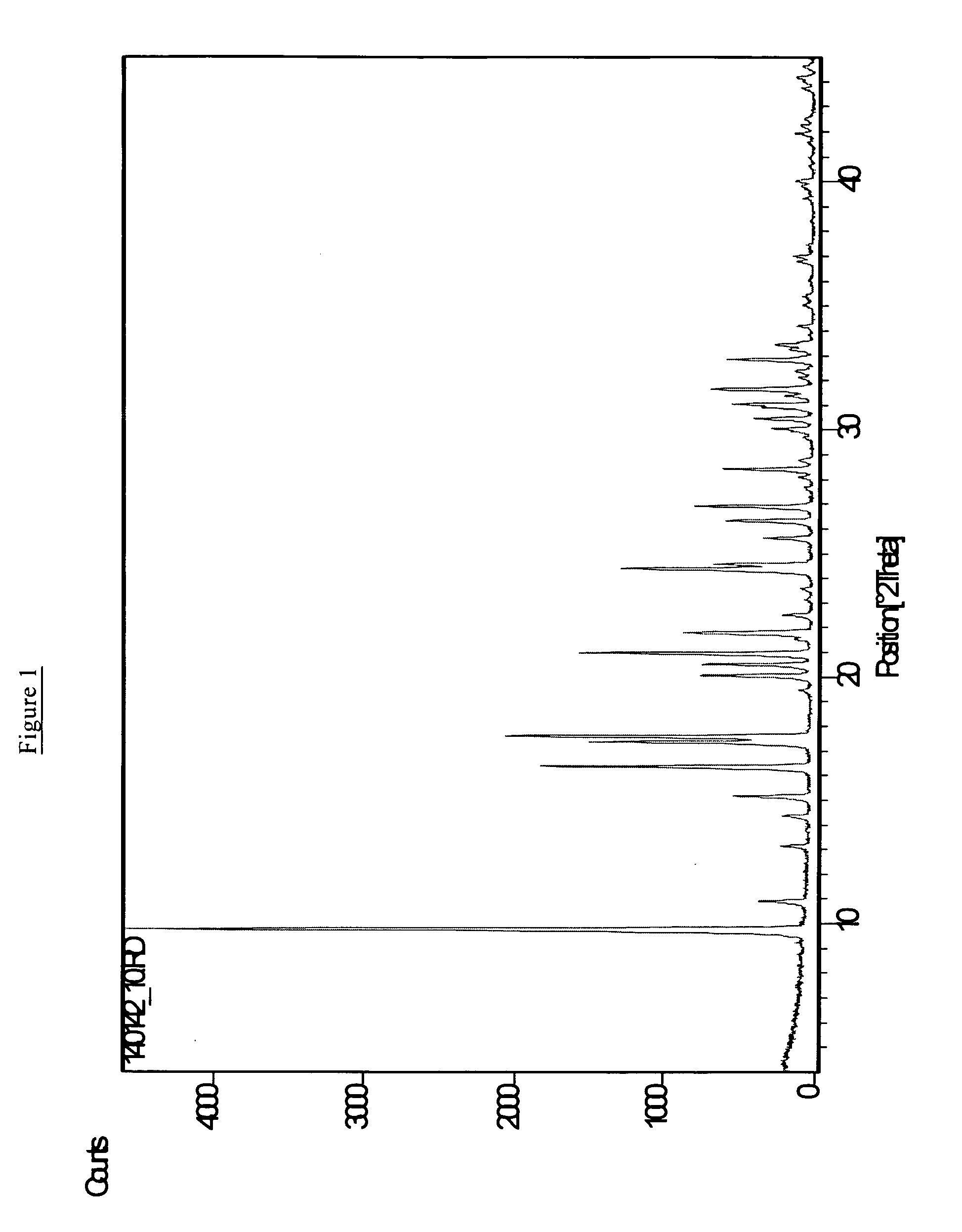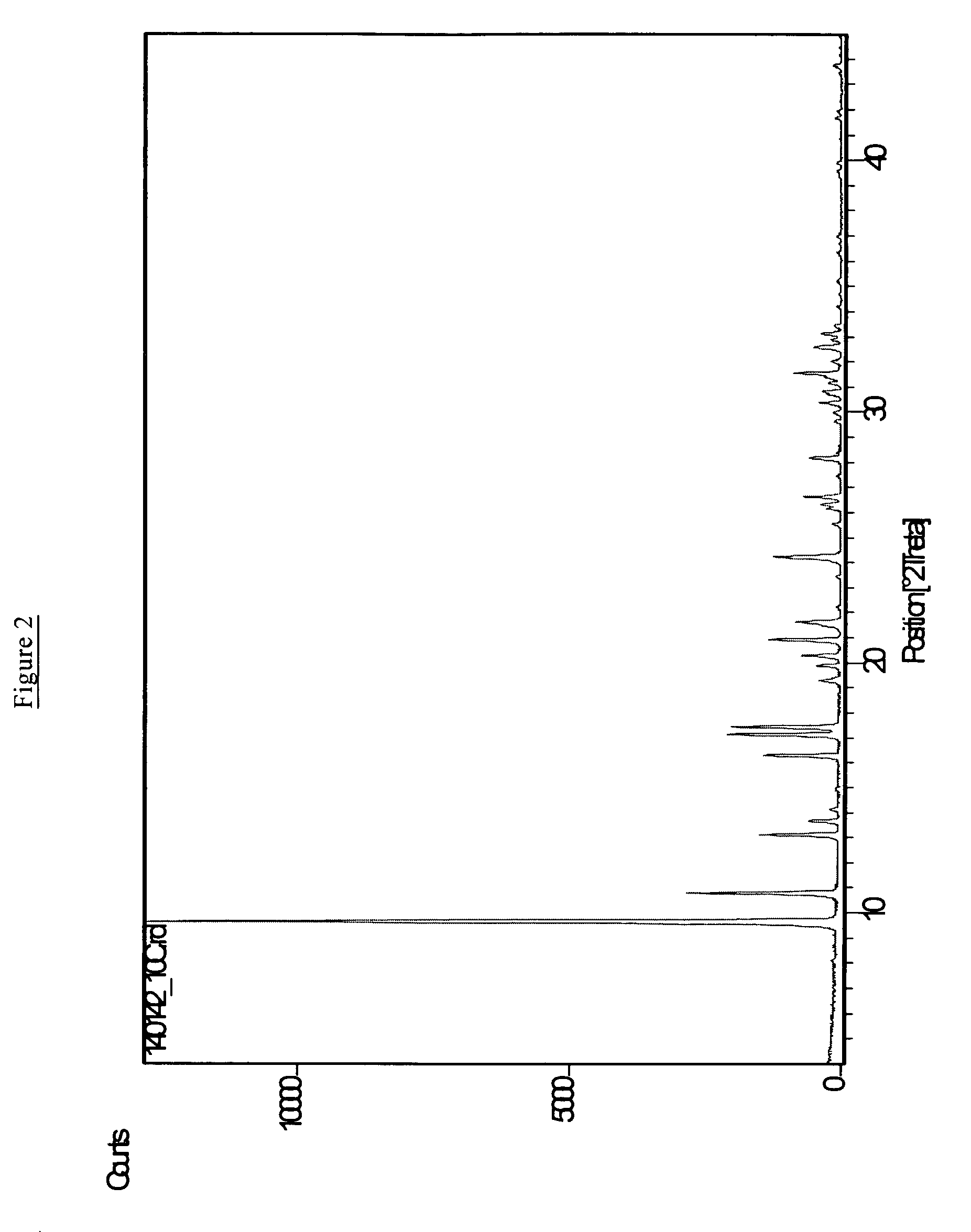AEI-Type zeolite, its synthesis and its use in the conversion of oxygenates to olefins
a technology of oxygenate and zeolite, which is applied in the field of zeolite, can solve the problems of limiting the catalyst life, increasing the potential for undesired secondary reactions, and lowering the diffusion rate of reactants and products
- Summary
- Abstract
- Description
- Claims
- Application Information
AI Technical Summary
Benefits of technology
Problems solved by technology
Method used
Image
Examples
example 1
[0058]0.143 ml of a 23.5 mg / ml aqueous solution of Al(NO3)3.9H2O was added to 3.717 ml of a 0.7236 molar aqueous solution of N,N-diethyl-2,6-dimethylpiperidinium hydroxide (DEDMP+ OH−) followed by 1.200 ml of tetraethylorthosilicate. The resultant mixture was continuously stirred in a sealed container for 2 hours at room temperature until all the tetraethylorthosilicate was completely hydrolyzed. To the resultant clear solution was added 0.117 ml of a 48 wt % aqueous solution of hydrofluoric acid which immediately resulted in the production of a slurry. This slurry was further homogenized by stirring and exposure to air for evaporation of water and ethanol until a thick slurry mixture was obtained. Extra water was further evaporated from the slurry mixture under static conditions to give 1317 mg of a dry gel solid having the following molar composition:
SiO2:0.00083Al2O3:0.5DEDMP:0.6F:4.9H2O
[0059]To this solid was added with mechanical mixing 5 mg (0.38 wt % based on the dry gel soli...
example 2
[0064]The as-synthesized material from Example 1 was pressed to a pellet at 30,000 psig (2.07×105 kPa) and then ground and sieved to between 80 and 125 μm. Two separate samples of the sized material were weighed between 21 and 22 mg and mixed separately with 90 mg of 100 μm silicon carbide. These mixtures were loaded into separate 1.9 mm internal diameter tubes sealed at the bottom with a quartz frit. The tubes were sealed into heated reactor blocks and the catalysts were then calcined at 540° C. under flowing air for 2 hours to effect organic template removal. The calcined catalysts were then subjected to methanol under a variety of conditions as detailed below.
[0065]Condition 1: The catalysts were contacted with a mixture of 85% methanol in N2 at 540° C., approximately 100 weight hourly space velocity (WHSV), and 40 psia (276 kPa) methanol partial pressure. During the methanol reaction, the reactor effluents were collected and stored at timed intervals for analysis by gas chromato...
example 3
[0070]The procedure of Example 1 was repeated but with the scale of preparation being 10 times that in Example 1, otherwise all parameters being the essentially the same. In a first preparation the hydrolysis of the tetraethylorthosilicate in N,N-diethyl-2,6-dimethylpiperidinium hydroxide was carried out for two hours, while in a second preparation the hydrolysis was for 16 hours. In the first case the resulting product was a mixture of AEI and SFF framework-types materials; whereas in the second case an essentially pure phase having the AEI framework-type was produced. The pure AEI phase had a Si / Al ratio of 233 by chemical analysis, and a thick plate morphology with a size of about 0.8 micron thick by about 1.0 micron wide and about 1.0 micron long.
PUM
| Property | Measurement | Unit |
|---|---|---|
| temperature | aaaaa | aaaaa |
| temperature | aaaaa | aaaaa |
| molar ratio | aaaaa | aaaaa |
Abstract
Description
Claims
Application Information
 Login to View More
Login to View More - R&D
- Intellectual Property
- Life Sciences
- Materials
- Tech Scout
- Unparalleled Data Quality
- Higher Quality Content
- 60% Fewer Hallucinations
Browse by: Latest US Patents, China's latest patents, Technical Efficacy Thesaurus, Application Domain, Technology Topic, Popular Technical Reports.
© 2025 PatSnap. All rights reserved.Legal|Privacy policy|Modern Slavery Act Transparency Statement|Sitemap|About US| Contact US: help@patsnap.com


